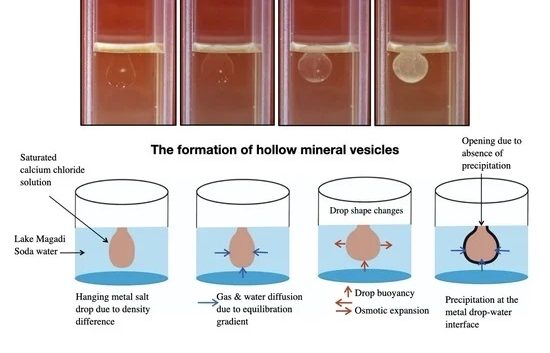Melese Getenet, Juan Manuel García-Ruiz, Cristóbal Verdugo-Escamilla and Isabel Guerra-TGetenet, M.; García-Ruiz, J.M.; Verdugo-Escamilla, C.; Guerra-Tschuschke, I. Mineral Vesicles and Chemical Gardens From Carbonate-Rich Alkaline Brines of Lake Magadi, Kenya. Crystals 2020, 10, 467.
Download here: https://www.mdpi.com/2073-4352/10/6/467
Mineral vesicles and chemical gardens are self-organized biomimetic structures that form via abiotic mineral precipitation. These membranous structures are known to catalyze prebiotic reactions but the extreme conditions required for their synthesis has cast doubts on their formation in nature. Apart from model solutions, these structures have been shown to form in serpentinization-driven natural silica-rich water and by fluid-rock interaction of model alkaline solutions with granites. Here, for the first time, we demonstrate that self-assembled hollow mineral vesicles and gardens can be synthesized in natural carbonate-rich soda lake water. We have synthesized these structures by a) pouring saturated metal salt solutions, and b) by immersing metal salt pellets in brines collected from Lake Magadi (Kenya). The resulting structures are analyzed by using SEM coupled with EDX analysis, Raman spectroscopy, and powder X-ray diffraction. Our results suggest that mineral self-assembly could have been a common phenomenon in soda oceans of early Earth and Earth-like planets and moons. The composition of the obtained vesicles and gardens confirms the recent observation that carbonate minerals in soda lakes sequestrate Ca, thus leaving phosphate behind in solution available for biochemical reactions. Our results strengthens the proposal that alkaline brines could be ideal sites for “one-pot” synthesis of prebiotic organic compounds and the origin of life.


